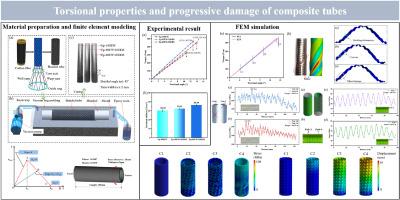交联剂增强环氧树脂改善碳纤维编织管的抗扭性能:失效机制的多尺度分析
IF 9.8
1区 材料科学
Q1 MATERIALS SCIENCE, COMPOSITES
引用次数: 0
摘要
本文研究了含有交联剂改性基体的编织碳纤维环氧管的扭转破坏机制。测试了三种环氧树脂配方:非交联树脂、含10% DDS交联剂的树脂和含20% DDS的树脂。采用真空辅助树脂注射成型方法制备样品。扭转测试表明,与非交联体系相比,DDS的加入使体系的刚度提高了19.8%,峰值扭矩提高了42.1%,但DDS含量的增加降低了失效应变。结合纱线均质和黏结区界面的多尺度有限元模型的实验相关性达到95%以上。渐进式损伤分析揭示了三个连续的破坏阶段:纱线交叉处的初始树脂开裂,随后的应力失配界面剥离,以及最终的纱线断裂。10 wt%的DDS配方优化了强度-刚度-韧性平衡,而纱线交叉处的应力集中(局部增强系数为1.8-2.2)被确定为关键失效起始点。这些结果证实,交联剂增强的界面显著提高了扭转阻力。本文章由计算机程序翻译,如有差异,请以英文原文为准。

Crosslinker-enhanced epoxy resin improves torsional resistance of carbon fiber braided tubes: multiscale analysis of failure mechanisms
This paper examines torsional failure mechanisms in braided carbon fiber epoxy tubes incorporating crosslinker modified matrices. Three epoxy formulations were tested: non crosslinked resin, resin containing 10 wt% DDS crosslinker, and resin containing 20 wt% DDS. Specimens were fabricated using vacuum assisted resin infusion molding. Torsion testing demonstrated that DDS addition increased stiffness by 19.8 % and peak torque by 42.1 % versus non crosslinked systems, though higher DDS content reduced failure strain. A multiscale finite element model integrating yarn homogenization and cohesive zone interfaces achieved over 95 % experimental correlation. Progressive damage analysis revealed three sequential failure stages: initial resin cracking at yarn intersections, subsequent interfacial debonding from stress mismatch, and ultimate yarn fracture. The 10 wt% percent DDS formulation optimized strength stiffness toughness balance, while stress concentrations at yarn crossovers with local enhancement factors of 1.8–2.2 were identified as critical failure initiation sites. These results confirm that crosslinker enhanced interfaces significantly improve torsional resistance.
求助全文
通过发布文献求助,成功后即可免费获取论文全文。
去求助
来源期刊

Composites Science and Technology
工程技术-材料科学:复合
CiteScore
16.20
自引率
9.90%
发文量
611
审稿时长
33 days
期刊介绍:
Composites Science and Technology publishes refereed original articles on the fundamental and applied science of engineering composites. The focus of this journal is on polymeric matrix composites with reinforcements/fillers ranging from nano- to macro-scale. CSTE encourages manuscripts reporting unique, innovative contributions to the physics, chemistry, materials science and applied mechanics aspects of advanced composites.
Besides traditional fiber reinforced composites, novel composites with significant potential for engineering applications are encouraged.
 求助内容:
求助内容: 应助结果提醒方式:
应助结果提醒方式:


